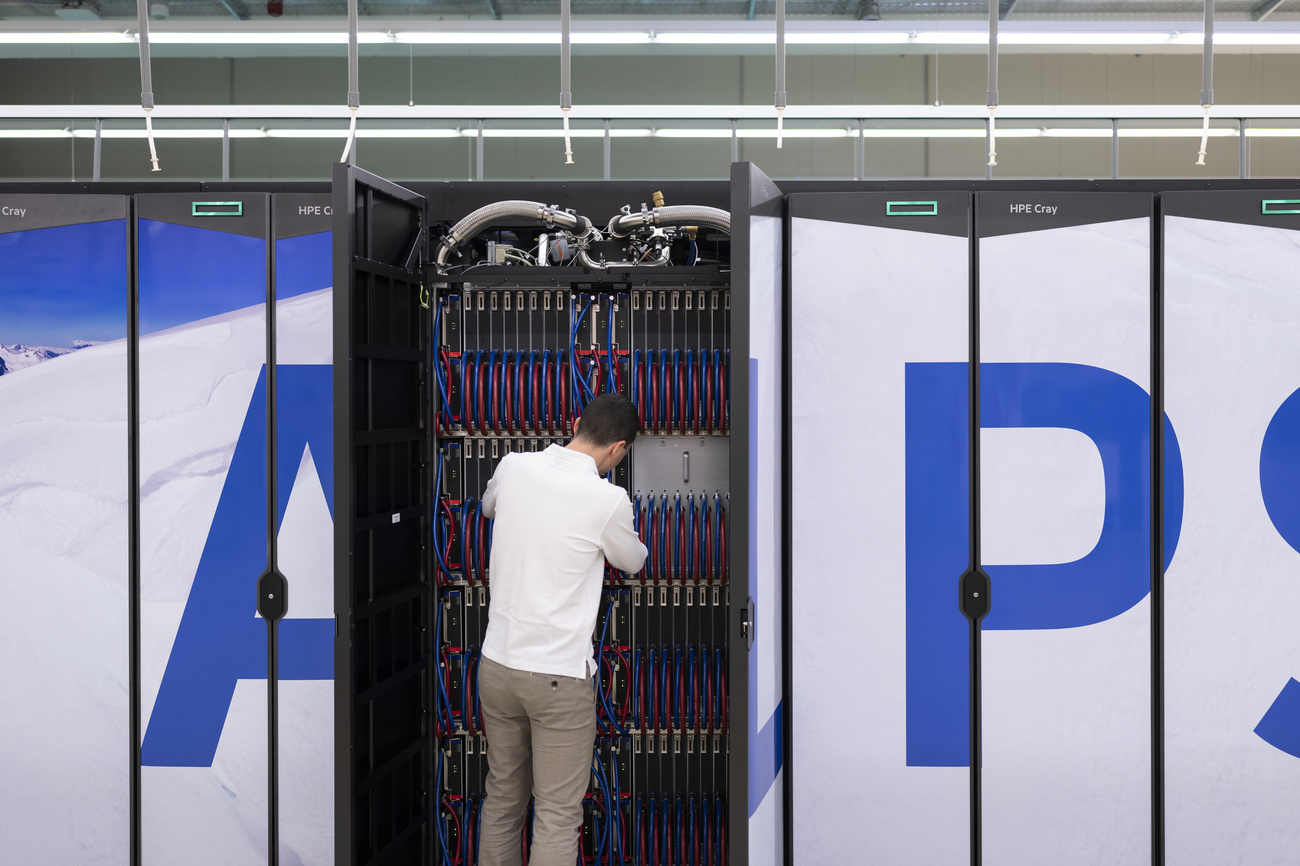
AI giants accused of hiding environmental footprint

The boom in artificial intelligence (AI) comes with environmental costs that are still largely hidden. Ahead of the AI for Good summit in Geneva, Sasha Luccioni, a researcher specialising in the ecological footprint of AI, gives Swissinfo her critical view.
“Our future is a race between the growing power of our technology and the wisdom with which we use it,” wrote physicist Stephen Hawking in 2018, shortly before his death. Just a few years later, artificial intelligence has become part of our daily lives: shopping recommendations, intelligent navigation, automatic translations, chatbots…
Behind these seemingly dematerialised uses, supported by “clouds” or “virtual clouds”, lie very real infrastructures that consume energy, water and metals, and whose environmental cost is often overlooked.
Sasha Luccioni sets out to unravel this paradox of dematerialisation. A computer scientist and climate manager at Hugging Face, an open-access artificial intelligence platform, she warns of the ecological and ethical abuses of a technology that is evolving faster than our ability to grasp its consequences, and with increasing opacity. Swissinfo caught up with her ahead of her appearance at the AI for Good summitExternal link, to be held in Geneva from July 8-11.

“There’s a real disconnect between the interfaces we use – such as ChatGPT or Siri – and the hardware reality of the servers that run them,” Luccioni says. This discrepancy is fuelling a rebound effect known as the Jevons paradox. “Even though AI is becoming more efficient, its energy consumption is increasing because it’s now used everywhere: in voice assistants, smart fridges, personalised advertising, online searches and so on,” she adds. In four months, the number of weekly users of ChatGPT has doubled to 800 million.
Energy-hungry data centres
It is the overuse of generative AI – capable of generating text, images or music from machine learning models, like ChatGPT – at which Luccioni is pointing the finger in particular. “Generative AI consumes 20 to 30 times more energy than traditional AI to answer a factual question, according to a study we conducted in 2024.”
According to a recent report External linkby the International Telecommunication Union (ITU), the power consumption of data centres, which are essential to the operation of AI and the cloud, grew by 12% a year between 2017 and 2023 – four times faster than global electricity demand. According to the International Energy Agency, their consumption could double by 2030 to reach 945 TWh, more than Japan (900 Twh) and Switzerland (60 TWh).
A cloud generated by coal and gas
Luccioni warns that this unbridled growth is outstripping the deployment capacity of renewable energies.
“Building solar panels or wind turbines takes time, but AI is developing at a lightning pace,” she says. “It is therefore often powered by non-renewable energy sources, such as gas or coal, at a time when we should be decarbonising our societies.”

As a result, throughout the world, gas and coal-fired power stations are being revived to supply data centres, as in Ireland, where the electricity network is reaching its limits because of their expansion. In Memphis, in the United States, the gas turbines of an Elon Musk centre are causing controversy, while in April US President Donald Trump signed decrees aimed at reviving coal mining, citing the rise of AI. According to the ITU, emissions linked to the activities of AI giants have increased by an average of 150% since 2020.
AI, thirsty for water and metals
AI’s ecological footprint is not confined to its electricity consumption. “The growth of generative AI models also requires large quantities of critical metals and water to build infrastructures and cool servers,” Luccioni stresses. As a result, new mines are emerging. “We recycle so few electronic components that almost all the metals required come from intensive, often polluting, extraction.”

More
Inside Geneva: is AI a risk to democracy?
According to a study External linkpublished in the scientific journal Nature Computational Science, generative AI generated 2,600 tonnes of electronic waste in 2023. This figure could rise to 2.5 million tonnes by 2030, according to the researchers – equivalent to 13.3 billion discarded smartphones.
As for water, the OECD estimates that AI could consume up to 6.6 billion cubic metres of water a year by 2027External link, twice the annual consumption of Switzerland.
Lack of transparency
Artificial intelligence is evolving faster than our understanding of its environmental consequences. “It’s almost impossible to estimate actual energy consumption, because the AI giants refuse to disclose this data,” laments Luccioni, who published a ground-breaking study on the subjectExternal link in June.
The results are striking: in May 2025, 84% of requests addressed to conversational robots were processed by models whose environmental footprint remains completely opaque, including ChatGPT. Only 2% of models communicated their carbon impact.
“What’s worrying is that the use of AI is constantly increasing, while transparency is decreasing,” Luccioni says.

This opacity encourages the propagation of dubious and often erroneous figures, such as the claim that ChatGPT consumes at least ten times more energy than a Google search. In a blog published in JuneExternal link, Sam Altman, CEO of OpenAI, claimed that each ChatGPT request consumed around 0.34 watt-hours of energy – “about what an oven would use in a little over one second”, according to Altman.
“These figures are not verifiable, yet they are taken at face value,” Luccioni says. “Even if this estimate were correct – which remains to be proven – multiplied by the billions of daily requests, the overall energy consumption would be colossal. And that’s without taking into account the generation of images, which consumes much more energy.”

More
What’s the environmental cost of Switzerland’s new supercomputer?
Towards more sustainable AI?
Although the United Nations adopted a resolutionExternal link in 2024 in favour of global governance of artificial intelligence, this has been slow to materialise.
“AI is evolving so quickly that it’s difficult to regulate. The most urgent thing is to break up the monopolies of the big tech companies,” argues Luccioni. “The more we diversify the players, the more we will encourage transparency and environmental responsibility.”
More
Some data centres are looking to reduce their footprint, in particular by recovering the heat produced by their servers. For Sasha Luccioni, one avenue for improvement lies in the development of more energy-efficient AI models.
“Smaller, more specialised models consume less energy and are more accessible to independent developers,” she says. She also cites greener alternatives, such as the Ecosia search engine, which is powered by renewable energy.
Looking beyond companies, she calls on decision-makers to demand greater transparency. “It’s absurd that there is no clear information on the source of the energy or the actual consumption of these systems. Even companies that are concerned about their environmental impact do not have the means to make informed choices.”
This awareness could also be raised at an individual level, by rethinking the way we do things. “Using generative AI to obtain factual information such as a chemist’s timetable or a recipe is like turning on the floodlights in a stadium to look for your keys.”
In mid-June, an MIT studyExternal link showed that ChatGPT could considerably reduce our brain activity, particularly in areas linked to attention, planning, memory and critical thinking.
“This is all the more worrying because AI often produces false information – the famous hallucinations. We’re becoming dependent on an unreliable technology,” Luccioni warned.
AI at the service of the environment?
Environmental issues will occupy only a marginal place at the AI for Good summit in Geneva, which aims to highlight the positive applications of AI.
“Several non-generative AI methods are already making it possible to detect extreme climatic events or to speed up the search for more durable materials for batteries or solar panels”, Luccioni says. The International Organisation for Migration (IOM), for example, is working with Microsoft to use AI to anticipate population movements linked to climate changeExternal link.
“We must continue to demand answers about the reliability, rigour and environmental footprint of AI, as we would for any technology that enters our lives,” Luccioni concludes.
Edited by Virginie Mangin. Translated from French by DeepL/ts

In compliance with the JTI standards
More: SWI swissinfo.ch certified by the Journalism Trust Initiative































You can find an overview of ongoing debates with our journalists here . Please join us!
If you want to start a conversation about a topic raised in this article or want to report factual errors, email us at english@swissinfo.ch.